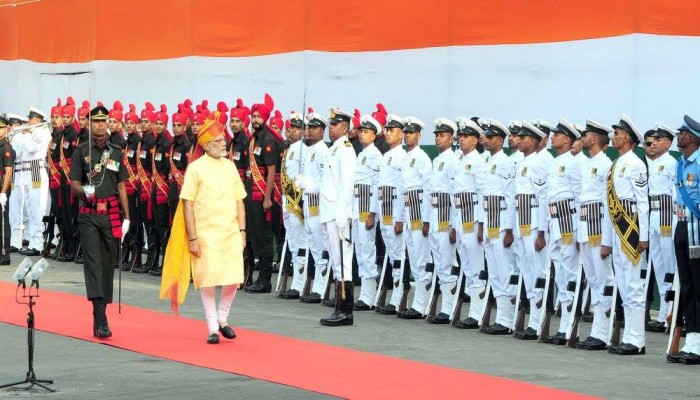Doklam Standoff Episode: A new milestone in Indian Diplomacy under Narendra Modi
- In Foreign Policy
- 09:37 AM, Aug 30, 2017
- Ramaharitha Pusarla
The Doklam standoff which began on June 16th with Indian troops stopping the road construction of PLA troops successfully ended. 10 weeks of sustained negotiations through diplomatic channels led to mutual disengagement of troops from the Doklam region. Unlike previous border incursions, China escalated the border issue and remained defiant. Playing the victim card, Beijing adeptly distorted historical facts. Infringing mutually agreed terms of maintaining status quo in the region, Chinese troops intruded into the disputed trijunction Doklam. China adopted ‘maximalist approach’ and demanded unilateral withdrawal of Indian troops. The border standoff could have inadvertently flared up into an armed conflict as China espoused hostility. Simultaneously, China through its state sponsored launched unabated propaganda (psychological war) against India threatening it into pulling out troops without firing a single shot. But India remained unruffled by the raucous, war-mongering narrative of China. In sharp contrast, India’s approach was measured, matured and responsible and continued to engage with Chinese counterparts diplomatically.
Emboldened by its tact of bullying smaller neighbors into submission, China believed that penetrating the trijunction under the pretext of road construction in the strategically important Doklam region might be a cake walk. Acting upon Bhutan’s request, Indian troops held the ground and prevented PLA troops from extending the road towards the Jhamperi Bridge. Surprised by India’s unanticipated resistance, China portrayed India as an “intruder”, unilaterally changed the status quo and alleged that New Delhi violated its sovereignty. Hawkish sections of Communist Party, soon persisted that China shouldn’t agree for nothing less than complete evacuation of Indian troops from the region. Despite the Chinese belligerence, Indian troops stood its ground and Indian government achieved a significant breakthrough through backroom negotiations. The announcement of mutual disengagement of troops on 28th August by both sides came just a week ahead of the Annual BRICS summit to be held in China. But the rabble-rousing hawkish sections and jingoistic propaganda channels of Chinese media hours after the announcement maintained that it was a massive diplomatic victory for China. Giving a unilateral spin claimed that India troops were forced to leave Doklam. With international media giving credence to Chinese propaganda, Indian MEA officials issued another clarification in the evening reiterating that withdrawal of forces which was mutual has commenced and is under verification.
Aside seriously rallying for peaceful negotiations, the Modi government strengthened India’s position through extensive global outreach, bilateral engagements and thwarted Chinese attempts to overrun India by commissioning probes on Chinese investments.
International community closely watched the Doklam impasse because of its spiraling effect on the geopolitics and quantum of destruction in the event of a collision course between nuclear states. China’s contemptuous defiance of international laws and its expansive maritime actions in the South and East China Sea raised doubts about its peace rise ever since. Reiterating Chinese peaceful development policy, Liu Xiaoming, Chinese ambassador to UK, stated that “China has deterrence and wisdom to win without fighting. But if needed, China has the courage and capacity to win fighting. This is the essence of the Art of War and the soul of China’s military strategy today”. The Art of War of Sun Tzu has been corner stone of China’s foreign policy and source of soft power diplomacy. Emulating the crux of Sun Tzu’s philosophy, China not only occupied over 38,000 sq kilometers of Indian Territory but steadily established its control over various territorial features in South China Sea without fighting a war. Modi government having fortified Doklam region with armed contingent, prevailed on China to agree for mutual disengagement since, use of force by China, can inadvertently set a precedent that Beijing would use force to grab land. Essentially, Modi too without fighting a war, humbled the Middle Kingdom.
Overwhelmed by raising spiraling trade deficit, amid Doklam standoff India tightened its scrutiny against Chinese investments. India initiated 12 investigations against Chinese products including photovoltaic cells manufactured in China. New Delhi blocked $1.3 billion Shanghai Fosun Pharmaceutical Group acquisition of India’s Gland pharma (1). In the first week of August, India sought to invoke the principle of reciprocity in awarding projects to foreign companies. With threats of Cyberattacks becoming imminent, India ordered 21 Chinese telecom companies, commanding over 50% of domestic market to furnish details of safety and security practices.
In a bid to force India to withdraw its troops, China made several insidious remarks and even threatened to enter India through disputed territories. Days before Chinese envoy visit to Kathmandu, Weng Wenli, Deputy Director General of the Border and Ocean Affairs stated, “The Indian side has also many tri-junctions. What if we use the same excuse and enter the Kalapani region between China, India and Nepal or even into Kashmir region between India and Pakistan”. China aspired to be super power of Asia. But was wary of India’s rise and influence in South Asia. Beijing swiftly cultivated bilateral ties with India’s neighbors and wooed them with low interest loans, aid and infrastructure investment. China infused more energy into its ties with Nepal, when it briefly fell apart with India following Madhesi agitation (that crippled movement of all supplies across borders).
With its economic clout Beijing not only stoked anti-Indian sentiments but also aimed to turn Nepal away from India. A fortnight ago, Sushma Swaraj’s on visited Kathmandu for attending the meeting of foreign ministers of BIMSTEC. Nepal mindful of India’s concerns asserted that “Nepal does not want to be dragged into the boundary dispute between India and China. Both of our big neighbors should maintain cordial relations through peaceful diplomacy and dialogue”. Reiterating preeminence of Indo-Nepal ties, Prime Minister of Nepal Sher Bahadur Deuba made his first foreign visit to India. China intentionally escalated Doklam issue and incessantly referred to Bhutan as “protectorate of India” to drive wedge between India and Bhutan, the only country other than India who didn’t join OBOR.
European countries adopted a “wait and watch” approach towards Doklam support, US and UK supported India’s position of resolving the issue diplomatically, Japan whole-heartedly extended full support to India. It also warned Beijing shouldn’t make any attempts to unilaterally change the status quo in Doklam. While China made every possible attempt to stall India’s elevation on global arena, Modi through diplomatic outreach cobbled support of US and Israel during the Doklam standoff. In fact, India’s defense acquisitions received big boost with US clearing sale of predatory drones to India. Domestically, China’s tirade of raucous propaganda invigorated the nationalistic tendencies. President Xi commemorating 90th Anniversary of PLA, gave exhorted forces “to stand up to all enemies who offend China”. In contrast, Prime Minister Modi refrained from referring to Doklam issue both at the monthly Mann Ki Baat and on the eve of Independence Day.
India’s peaceful resolution of 72-day Doklam saga, not only neutralized China’s raw power and intimidation but it also encouraged small countries to resist China’s belligerence. The end of Doklam saga exemplifies strategic brilliance of Modi’s resolute yet amicable foreign policy. India’s clear-minded, flawless approach towards the Doklam issue now heralds a new beginning to India diplomacy beleaguered by absence of strategy and commitment. Critically acclaimed as being reactive, India’s mature response to Chinese jingoism positioned it as a responsible power.
End of Doklam standoff through mutual disengagement of troops is undoubtedly a momentous diplomatic victory for India. For the past seven decades, despite lofty intentions, India paid a heavy price for it’s botched up diplomatic stratagems. Further a lack of contiguous long standing foreign policy ruined Indian efforts of garnering support and solidarity of comity of nations. Humbling a revisionist China consumed by maritime and territorial expansion from position of strength is no mean effort. By coming to the rescue of smaller neighbor, India upheld agreement of friendship and invariably earned the trust of allies and neighbors. This may force Sri Lanka and Bangladesh to recalibrate their Chinese policy. India’s defiance to buckle down despite China’s belligerent rhetoric can instill new hope in smaller countries harassed by Beijing. While current political dispensation deserves all the praise for collective commendable efforts, China like Pakistan is a repeat offender. India must never let down its guard.
Alternatively, China’s climbdown must be analyzed through the prism of Xi’s political aspirations. Last week, there were speculations that Prime Minister Modi might skip BRICS meeting to be held at Xiamen, China. Though Modi may have other reasons, reports have linked this to prolonged Doklam standoff. China is very particular about public relations and to possibly any embarrassment, Beijing might have agreed to temporary withdrawal. Moreover, Xi, keen on consolidating his position as President for the next five years at the upcoming Communist Congress may hardly afford any armed conflict in the immediate neighborhood. Any irresponsible decision like eruption of war might have ruined his chances. Hence, some strategists argue that it might be too premature to rejoice the outcome of India’s meticulously charted Doklam diplomatic mission. Also, China hasn’t officially assured that it will steer clear of Doklam. In less than 24 hrs of announcement of mutual disengagement, the Chinese spokeswomen briefed that “We will make an overall assessment of the weather conditions and all related factors, and according to actual circumstances complete construction plans”.
Disclaimer: The opinions expressed within this article are the personal opinions of the author. MyIndMakers is not responsible for the accuracy, completeness, suitability, or validity of any information on this article. All information is provided on an as-is basis. The information, facts or opinions appearing in the article do not reflect the views of MyindMakers and it does not assume any responsibility or liability for the same.







Comments